Featured Comment
Exceptional. Subtle, sweet, smooth. I agree the croutons add a welcome crunch. Made fried ‘pancake’ with leftover corn skins. Everything was used, soothes my soul.
– Martha
Why mask corn’s natural sweetness when it’s already perfect?
The sweetness and depth of corn are truly remarkable, and this corn potage celebrates them without enhancers. No bouillon, sugar, or flour, just pure ingredients working in harmony.
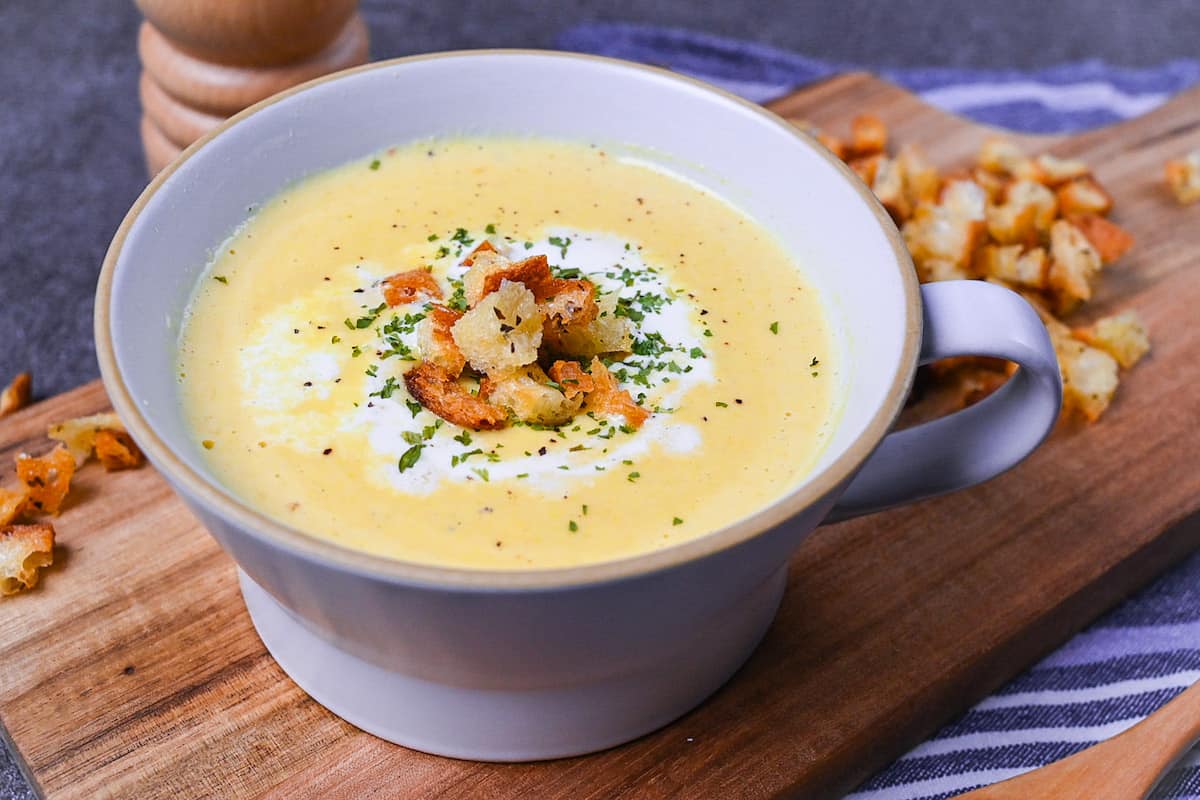
Ready to discover how this makes all the difference?
What is Corn Potage (Japanese Corn Soup)?
Corn potage (コーンポタージュ) is a thick, smooth soup made by puréeing corn into silky perfection. Derived from the French word “potage” meaning soup, it underwent a fascinating transformation in Japan.
What started as restaurant fare became a household staple, with Pokka’s innovative canned version revolutionizing convenience food in the 1970s.

Now, it’s a well-known Japanese comfort food, loved for its ability to warm you up. Its subtle sweetness and velvety texture make it perfect for winter, giving you comfort when you need it most.

Visual Walkthrough & Tips
Here are my step-by-step instructions for how to make Corn Potage at home. For ingredient quantities and simplified instructions, scroll down for the Printable Recipe Card below.
If you prefer to watch the process in action, check out my YouTube video of this Corn Potage recipe for a complete visual walkthrough!
First, preheat your oven to 180°C (360°F). Mix olive oil, melted butter, salt and dried herbs in a bowl until well combined, then add cubed baguette and toss until every piece is evenly coated.
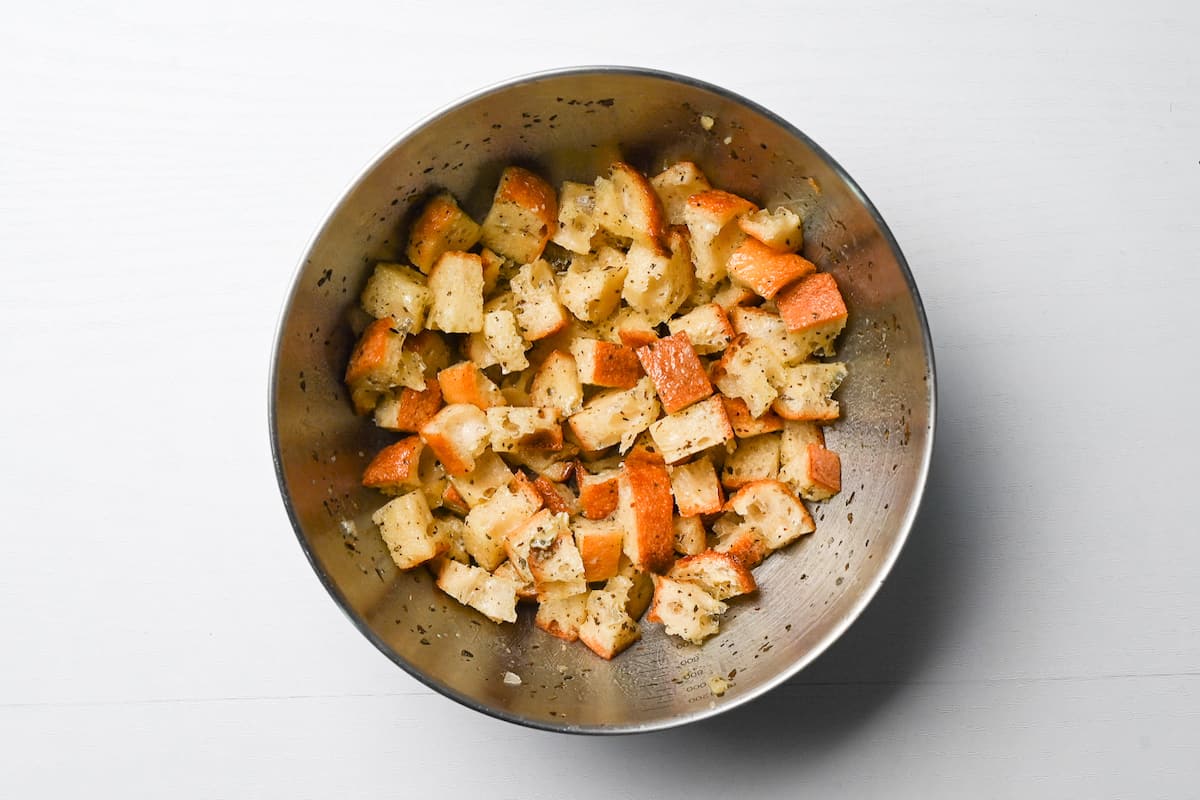
Spread the croutons over a baking tray in a single layer, ensuring they don’t overlap. This gives each piece equal exposure to heat for consistent browning.

Bake for 10 minutes or until golden and crispy, setting a timer to prevent overcooking.
This yields plenty of croutons for a generous topping. If you prefer just a light sprinkle, halve the quantities and enjoy the perfect crunch without leftovers.
While your croutons bake, prepare your corn by cutting off the kernels and cutting the cores into thirds or quarters. When using fresh corn, remove the husks and silk, then use a sharp knife to slice off the kernels.
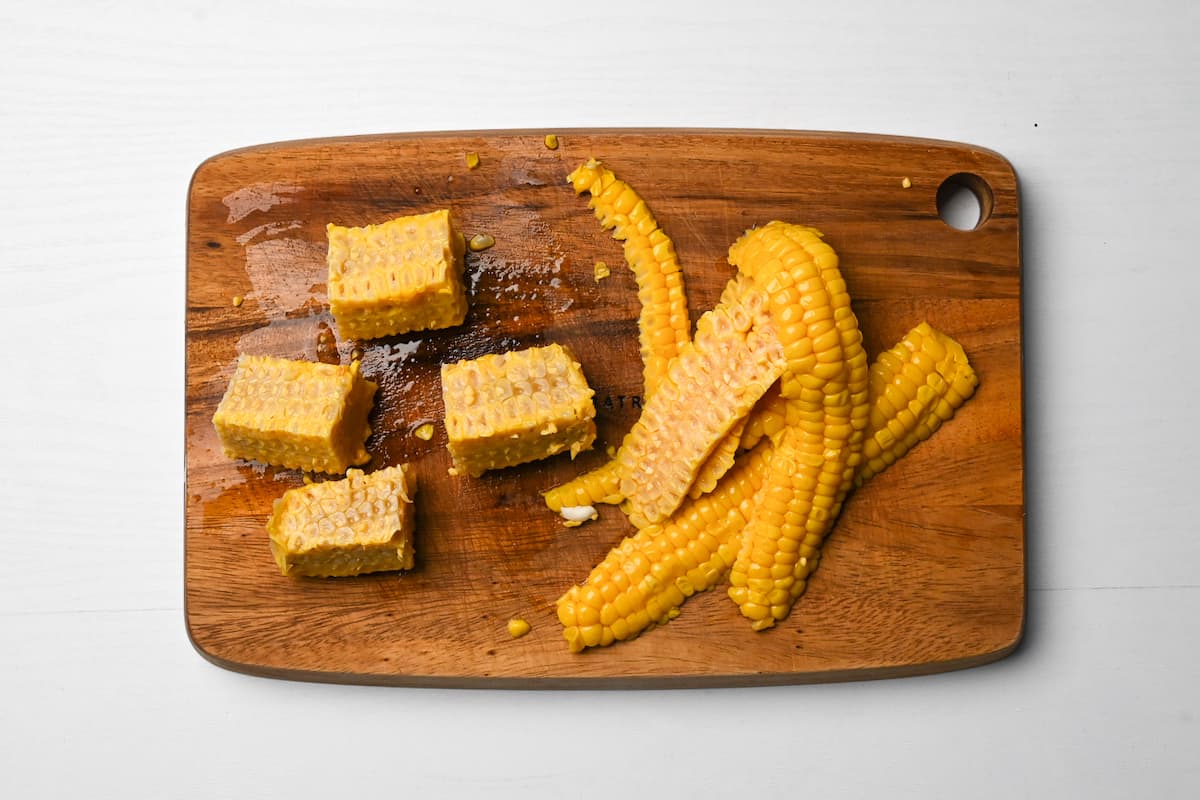
The key is to cut just deep enough to remove the kernels without going too deep into the cob. This keeps the tough outer skin of the kernels to a minimum for better texture.
They’re packed with flavor and will become the secret weapon in your soup’s depth of taste later.
Heat your pan or pot over medium heat and melt the butter. Add the onions and cook them until they become soft and translucent with golden edges.
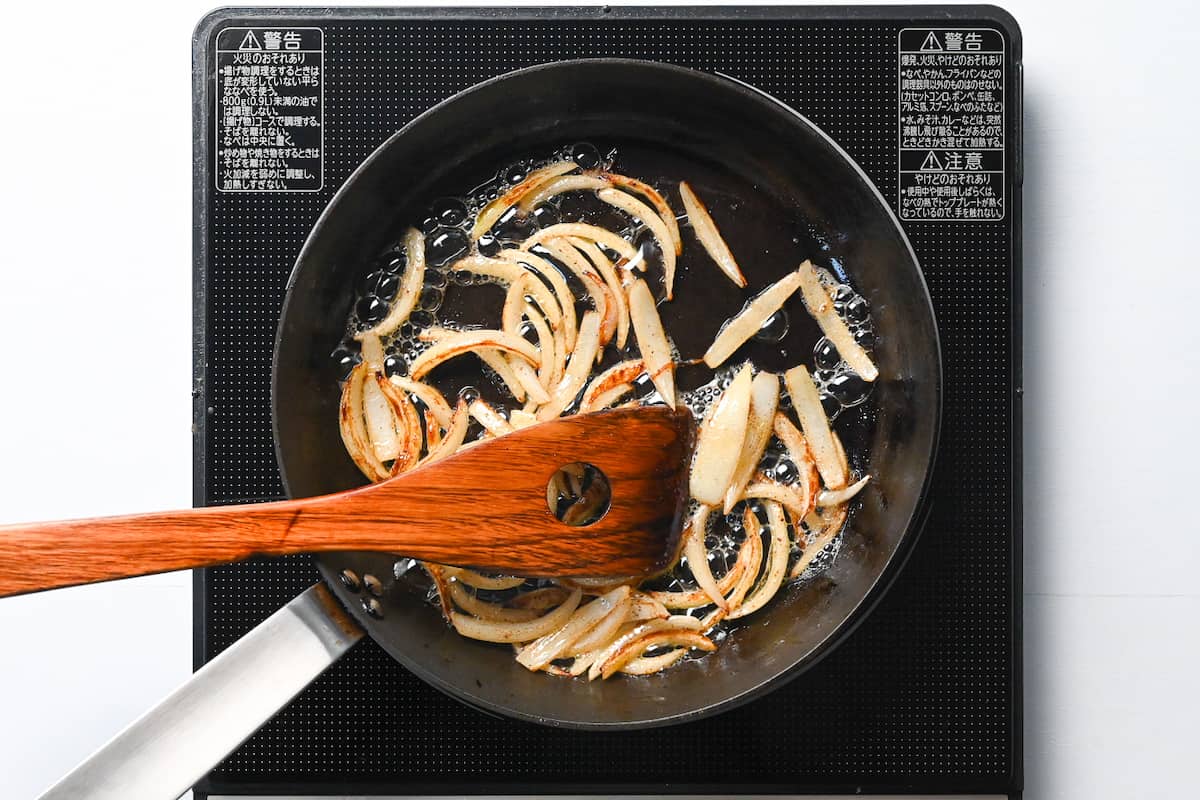
This process transforms the onions’ sharp bite into mellow sweetness that complements the corn’s natural sugar. Once they reach this point, reduce the heat to low.
Pour the whole milk into the pan with a pinch of salt and white pepper. If you prepared fresh corn cobs, nestle them into the milk and bring everything to a gentle simmer.
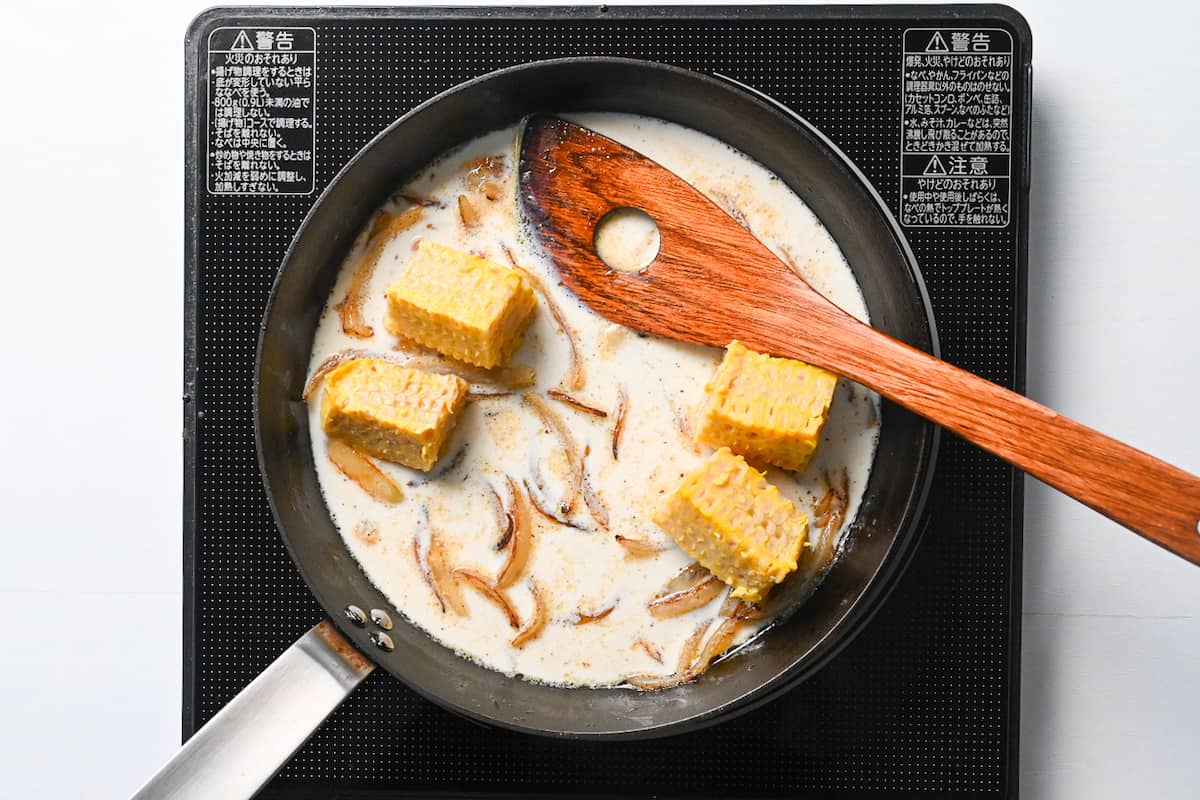
Corn cobs contain nearly as much sweetness and umami as the kernels themselves. The area between the kernels and the cob is rich in glutamic acid that creates natural flavor enhancement. By simmering the cobs, you’re essentially creating a vegetable stock that intensifies the corn flavor throughout your soup!
Milk proteins like casein and whey can get all clumpy and separated when you cook them at high temperatures. Keeping the temperature below a boil helps keep the creaminess and that silky mouthfeel.
Once you see tiny bubbles around the edges, turn off the heat and remove the corn cobs. Add the corn kernels with another pinch of salt and pepper again. Return to low heat and bring back to that same gentle simmer.
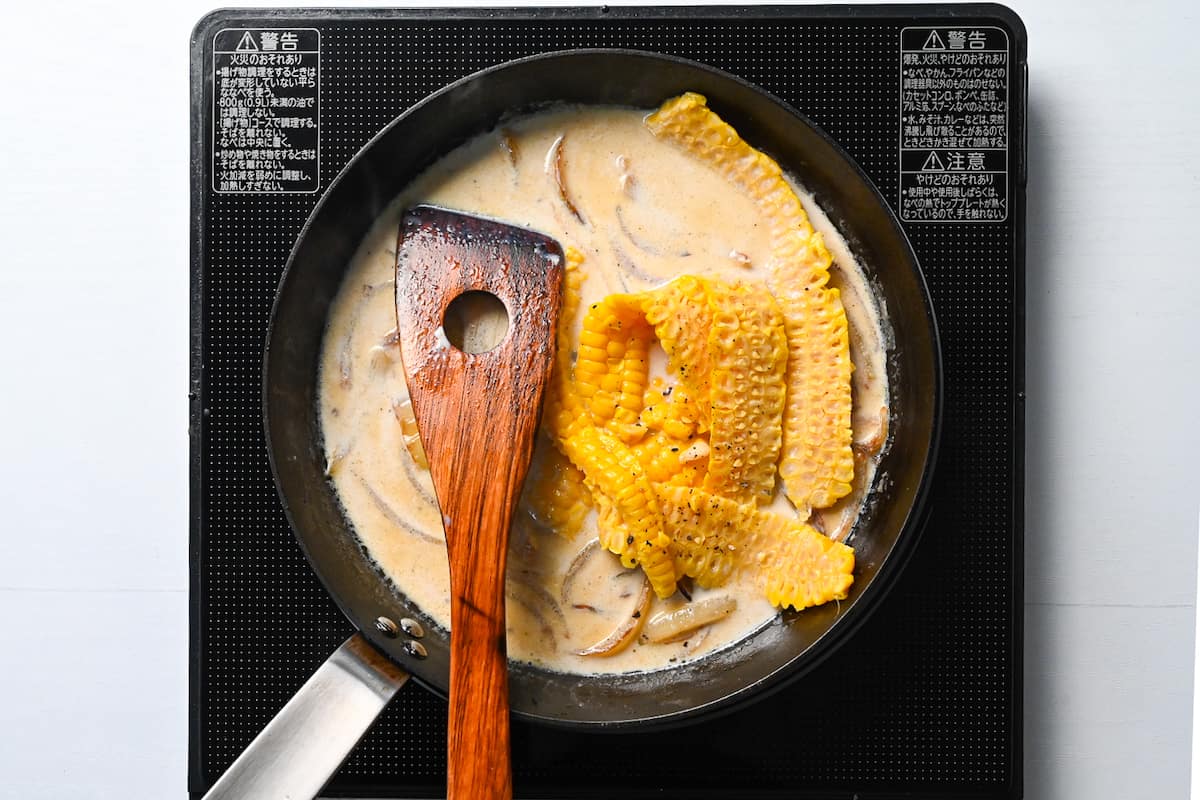
Watch for small bubbles to appear around the edges of your pot. This indicates your soup base is ready. Remove from heat and allow it to cool slightly before blending.
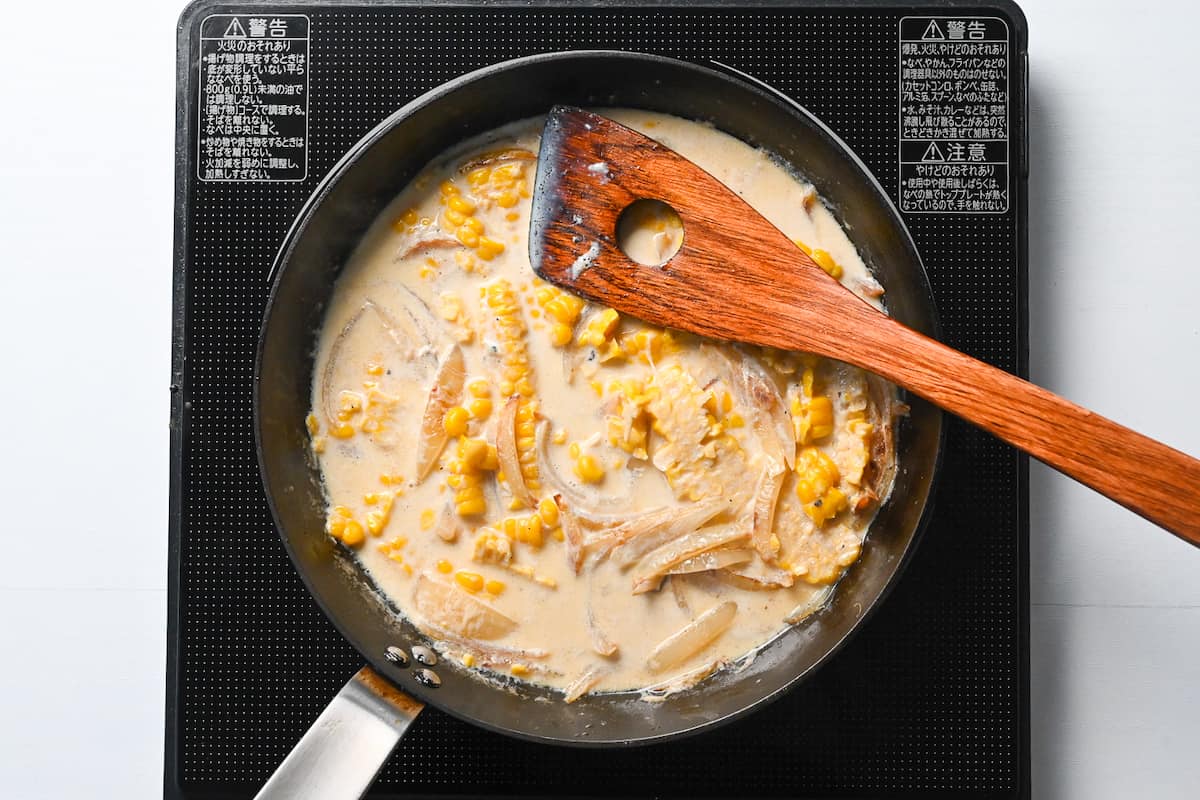
Transfer the corn potage to a blender, working in batches if necessary.
Of course, if you have an immersion blender, you can use that instead.
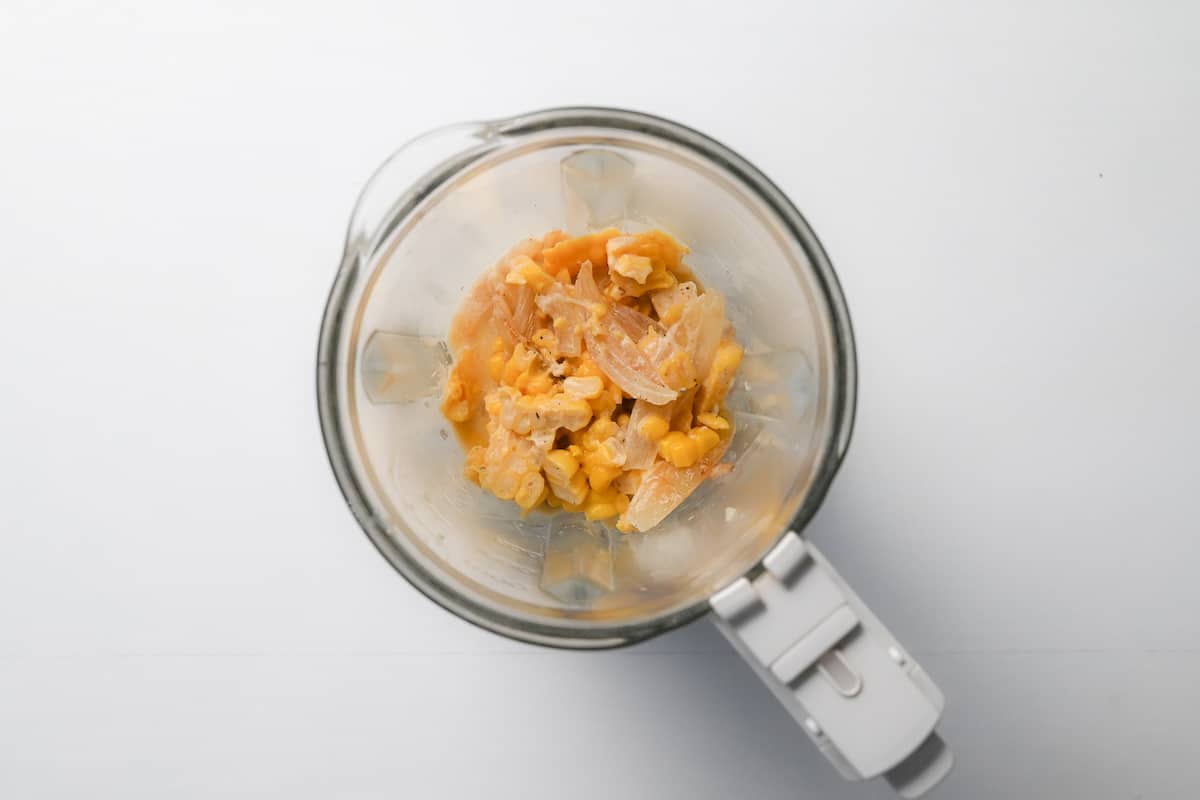
Blend until completely smooth. This usually takes 60-90 seconds depending on your blender’s power. The goal is a velvety consistency without any detectable pieces.
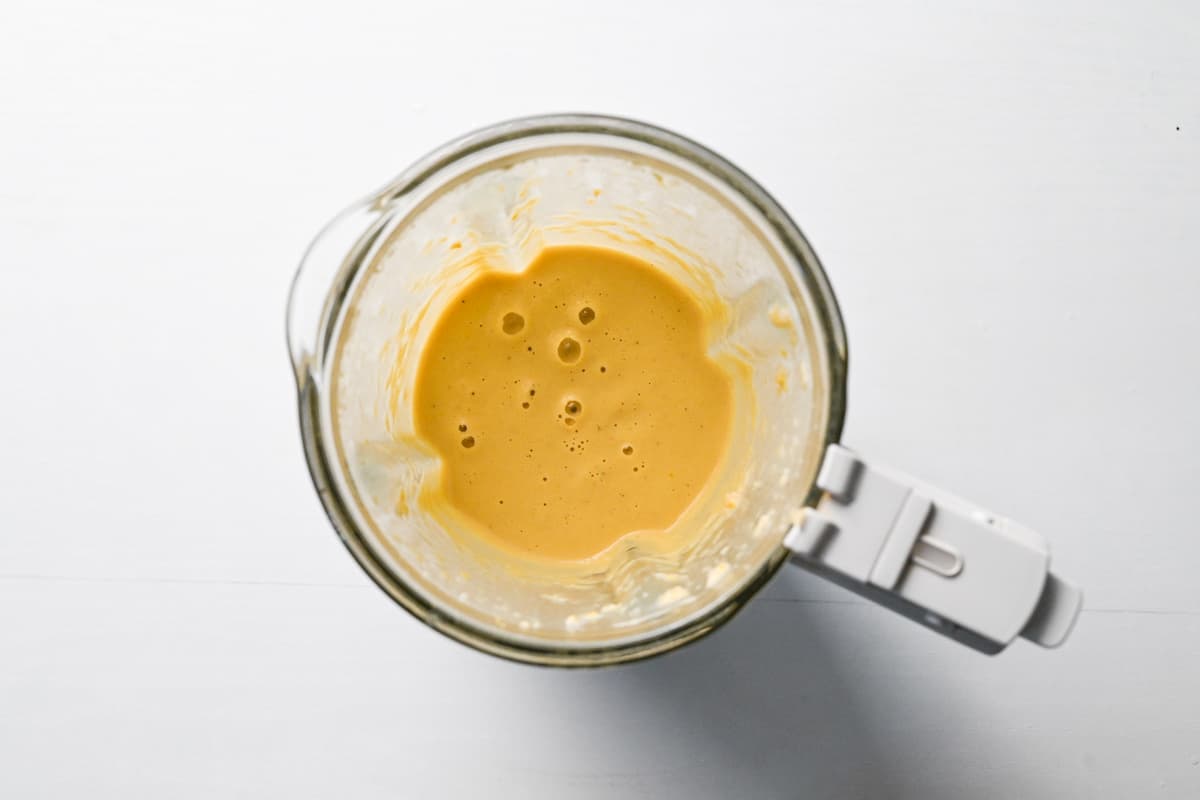
If you prefer some texture, pulse the blender for shorter intervals. For restaurant-quality smoothness, blend longer and consider the straining step that follows.
Pour the blended soup through a fine-mesh sieve, using a spatula to gently press the mixture through.

This removes any remaining fiber or small pieces that escaped the blender, resulting in a truly silky texture that coats the spoon.
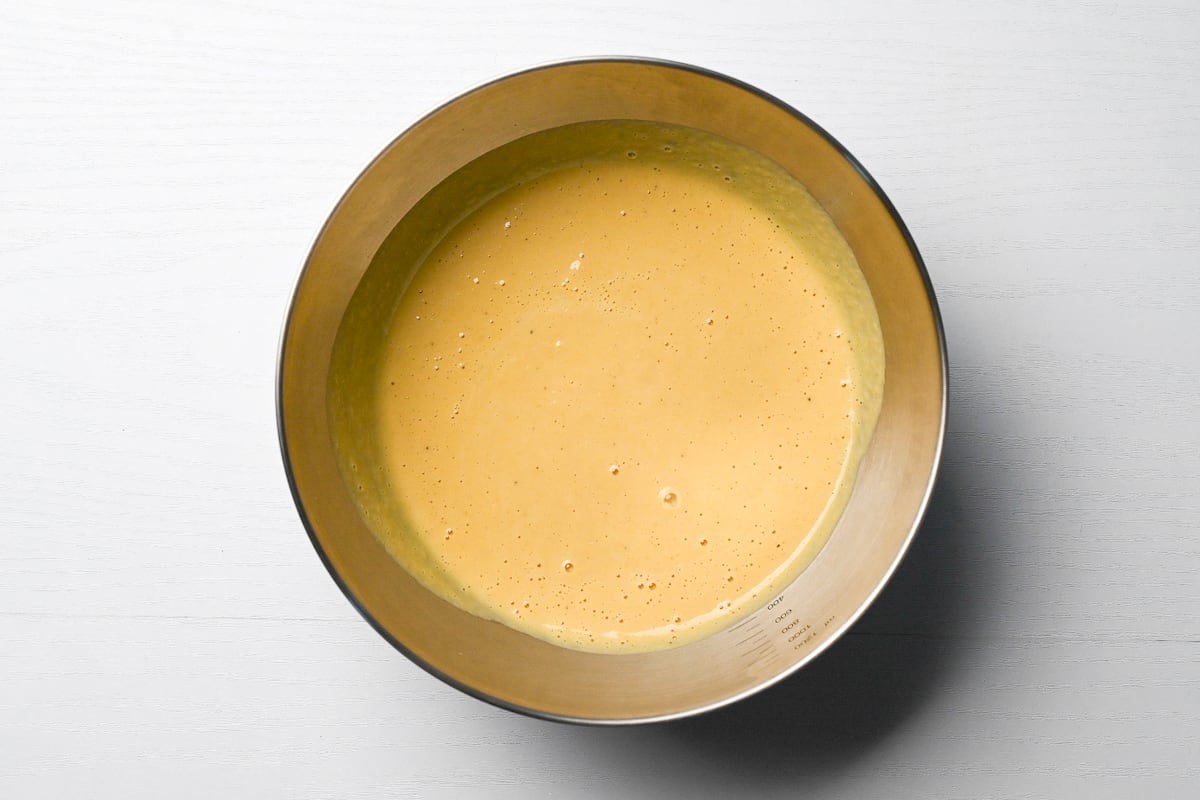
While straining is optional, it’s the difference between good homemade soup and a luxurious texture!
Taste and adjust the seasoning with salt and pepper.
Salt doesn’t just add saltiness, it also makes the corn’s natural sweetness stand out more. Add it gradually, tasting as you go. For example, when using peak-season fresh corn, you might find your soup tastes almost dessert-like in its sweetness, so you need to add salt to balance it out.
The goal is to reach a point where you taste the corn’s nice sweetness first, followed by a subtle richness that lingers pleasantly after each spoonful. Not sweet all the way.
Serve warm in bowls, drizzled with fresh cream (optional) and topped with your homemade croutons for the perfect balance of creamy comfort and satisfying crunch.
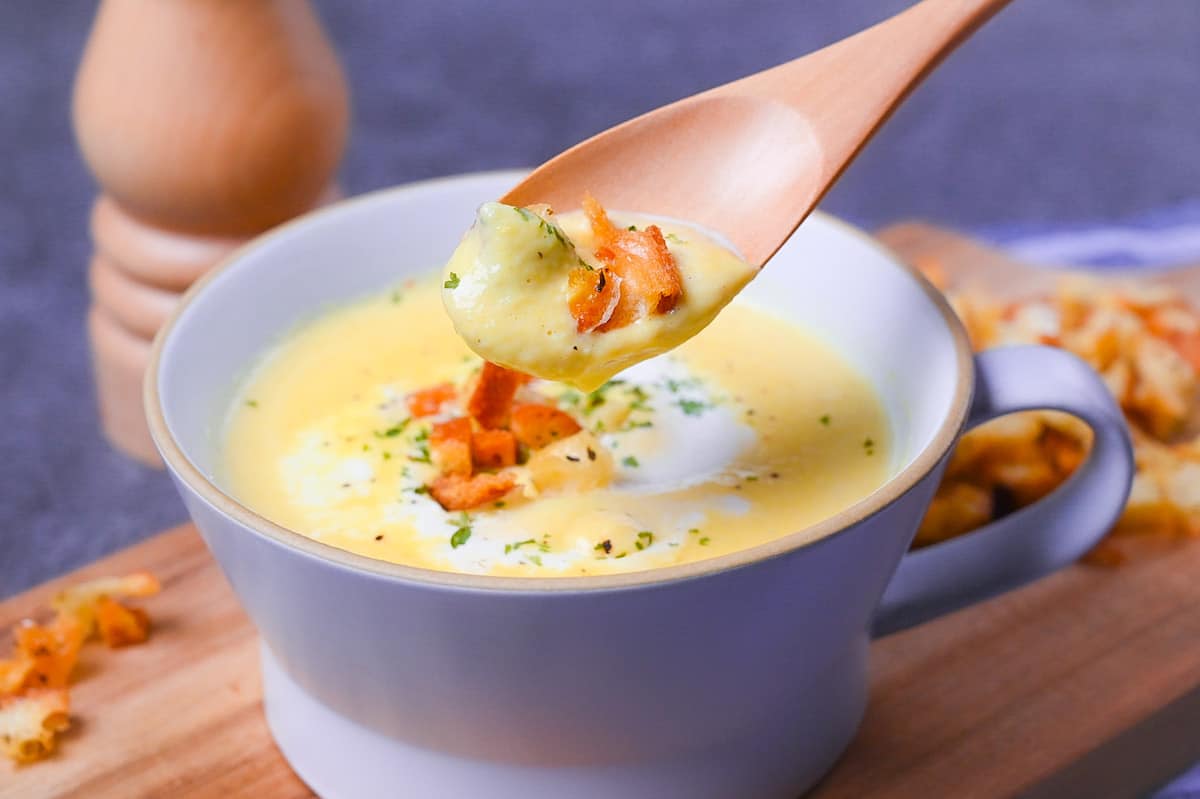

Essential Tips & Tricks
- Don’t discard the corn cobs. Simmer them in the milk to extract extra sweetness and body.
- Keep milk at a gentle simmer only.
- Strain the blended soup through a fine-mesh sieve for a silky finish.
- Add salt bit by bit while tasting at the end. You’re looking for enhanced sweetness, not too sweet, not too salty.
- Finish with freshly ground pepper to mask any faint dairy notes and lift overall flavor.
With these simple tips in mind, you’re set for success every time you make Corn Potage.
Meal Prep & Storage
This corn potage recipe is excellent for meal prep! Like many soups, the flavors actually improve after resting in the refrigerator as all the ingredients meld together beautifully.
Make the complete recipe including final seasoning, cool thoroughly, and store in airtight containers. The soup reaches peak flavor around 24 hours as the corn, milk, and seasonings fully integrate. Enjoy within 2-3 days for best quality.
For storage:
- Refrigerate: Cool the soup completely before transferring to airtight containers. Store for 2-3 days maximum. The soup will thicken as it chills due to the milk proteins, but this returns to normal when reheated.
- Freezer: For longer storage, freeze in portion-sized containers for 2-3 weeks. Cool completely before freezing and leave some headspace for expansion. Thaw overnight in the refrigerator before reheating.
- Reheating: Warm gently in a saucepan over low heat, stirring frequently to prevent scorching. If using microwave, heat in 30-second intervals, stirring between each interval.
The soup is also delicious served cold! The lower temperature creates a thicker, more luxurious texture that highlights the corn’s natural sweetness!
Serving Suggestions
FAQ
Here are answers to frequently asked questions I have received across all platforms, including here, YouTube, Instagram, and Pinterest. If you have any questions, feel free to send them to me anytime! It will be a big help for everyone in this community!
This happens when the milk gets too hot. Always keep the heat at medium-low after adding milk and never let it boil. If it does curdle, you can try blending it again to smooth it out somewhat, but the texture won’t be perfect.
This usually means you need more salt. Add it gradually while tasting. Salt enhances the corn’s natural sweetness.
Blend longer and strain through a fine-mesh sieve.

I hope you enjoy this Corn Potage recipe! If you try it out, I’d really appreciate it if you could spare a moment to let me know what you thought by giving a review and star rating in the comments below. It’s also helpful to share any adjustments you made to the recipe with our other readers. Thank you!
More Japanese Soup Recipes
- Chicken Miso Soup (Torijiru)
- Japanese Clear Soup (Osuimono)
- Ozoni (New Year’s Soup with Mochi)
- Kenchin Jiru (Traditional Japanese Vegetable Soup)
Want more inspiration? Explore my Japanese Soup Roundup Post for a carefully selected collection of tasty recipe ideas to spark your next meal!

Corn Potage (Japanese Corn Soup) with Homemade Croutons
Ingredients
Croutons
- 150 g baguette cubed
- 1 tbsp olive oil extra-virgin
- 1 tsp dry mixed herbs Italian seasoning or herbs de Provence
- ⅛ tsp salt
- 1 tbsp butter melted
Corn Potage
- 2 ears corn on the cob whole, fresh preferred
- 2 tbsp butter
- 100 g onion thinly sliced
- 300 ml whole milk do not use low-fat
- salt and pepper
- heavy cream optional
- dried parsley
My recommended brands of ingredients and seasonings can be found in my Japanese pantry guide.
Can’t find certain Japanese ingredients? See my substitution guide here.
Instructions
Homemade Croutons
- Preheat the oven to 180 °C (356 °F). While you wait, mix 1 tbsp olive oil, 1 tbsp butter , 1 tsp dry mixed herbs and ⅛ tsp salt in a mixing bowl until well combined. Add the cubed 150 g baguette and mix until evenly coated.

- Spread the seasoned baguette over a baking tray in a single layer so no cubes are overlapping, then bake for 10 mins on the bottom shelf.

- Once golden and crispy, remove from the oven and set aside for later.

Corn Potage
- Wash 2 ears corn on the cob and slice off the kernels in rows. Cut the cores into thirds or quarters.

- Take a pot and heat it on medium. Melt 2 tbsp butter and add 100 g onion (finely sliced). Fry until soft and golden, then reduce the heat to medium-low.

- Add 300 ml whole milk to the pot and add the cores of cob along with a few pinches of salt and pepper.Continue to heat until it small bubbles start to appear on the surface. Do not let it boil. Turn off the heat, then remove and discard the cores.

- Add the corn kernels along with another pinch of salt and pepper, then return to a low heat.

- Heat gently until small bubbles start to appear on the surface, then remove the pot from the heat and leave to cool slightly.

- Blitz the soup thoroughly using your preferred method (immersion blender or heatproof blender).

- Pour the mixture through a fine mesh sieve for an extra smooth result.

- Reheat on the stove if necessary and season with extra salt and pepper to taste. Serve with a drizzle of heavy cream, a sprinkle of homemade croutons and dried parsley. Enjoy!
Video
Notes
- 1 ear of fresh corn is equal to approximately 200g (7oz) canned or frozen corn. If using canned corn, add it to the pan right after adding the milk.
- Never let the milk boil as this can cause curdling and ruin the soup’s smooth texture.
- Use a high power heatproof (glass) blender or immersion blender. If your blender jug is made of plastic, let the soup cool before blending.
- Add salt little by little while tasting to find the point where corn’s sweetness is enhanced without detecting saltiness.
- Store in refrigerator for 2-3 days or freeze for 2-3 weeks. Reheat gently while stirring to prevent scorching, and avoid boiling.
- Serving ideas: Hambagu, Ebi Furai, Teriyaki Chicken, Tonteki





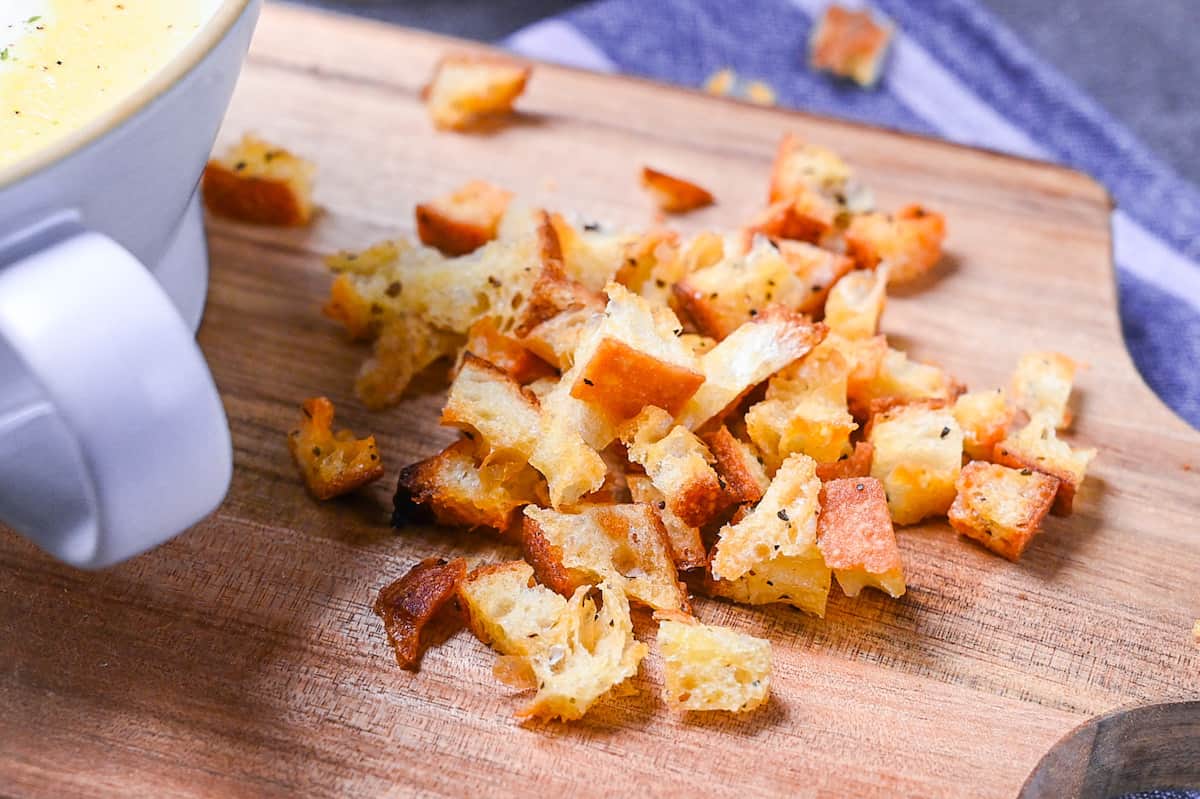
Have you tried this with soymilk or other non-dairy milks?
Hi Jan,
Thank you for the question!
I haven’t personally, but I’d assume it works with soymilk if you add a bit more flavor to it (e.g. a small amount of vegetable bouillon powder).
I hope this answer helps!
Yuto
Thank you for this!
After blending and straining, is it normal for there to be so much sweetcorn left in the sieve? It really felt like a lot. It had me wondering how much sweetcorn even made it into the finished meal 😅 I think the colour looks right?
Hi Matt,
Thank you for sharing your question along with the image! After blending and straining, there typically shouldn’t be many visible corn kernels remaining. The color of your dish looks spot on though! Honestly, even better than mine!
If you’d like to refine the texture further, you could try blending for a bit longer in short intervals, stirring in between, or experimenting with a different type of blender (e.g. immersion blender). Using a finer mesh sieve can also help achieve a smoother result. That said, I suspect that simply blending a little longer with pauses to stir will likely solve the issue! 🙂
Yuto
I’ve been buying the powdered version of Hokkaido corn soup for my father and came upon this recipe. Followed recipe exactly minus the croutons. He loved it, fresh corn in late July is so sweet!
Hi Jeannie,
Thank you so much for trying the recipe! I’m so glad both you and your father liked it. And yes! Peak summer corn always surprises me with how sweet it is! 🙂
Yuto
Exceptional. subtle, sweet, smooth. I agree the croutons add a welcome crunch.
Made fried ‘pancake’ with leftover corn skins. Everything was used, soothes my soul.
Hi Martha,
Thank you so much for making the recipe and sharing your photo! It looks wonderful! I’m so glad you enjoyed the soup, and I really love how you made use of the corn completely.
Yuto